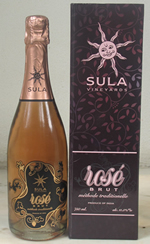|
Sula Vineyards has recently introduced the celebratory wine Sula Brut Rosé sparkling wine. A blend of Chenin Blanc and a small percentage of Zinfandel grapes, it is full of zing and zest and is quite a versatile wine that would go rather well with slightly spicy Indian and Chinese cuisine. In fact, I had my first bottle with a simple, home-cooked Chinese dish of hakka noodles and a shrimp and vegetable dish prepared by my wife who is an excellent cook and borders on being a Chef. There was a consensus on the dinner table that this was the best food and wine pairing- I am now dying to try it out with the Peking Duck at The China Kitchen at Hyatt Regency, the best in town and the one I love to have with a Rosé Brut from Laurent Perrier or Moet Chandon.
But, for a starter, it took a lot of effort to uncork the bottle. The standard procedure of untwisting the cage wire six times, holding and pressing the cork down with the palm of one hand and twisting the bottle back and forth with the other, just did not work. I almost gave up until I decided to open the cork by gradually pressing it out with the guided pressure of the thumb evenly around the bottle- it finally showed some signs of moving. After pushing out a few millimeters, I could go back and forth as in the standard procedure and the bottle was uncorked without any loud pop and spilling of the wine. A novice would certainly have had problems opening the bottle.
But when I poured the contents into the flutes, the bubbles came out dancing in thousands in the glass and kept up their performance till I finished my dinner and the bottle was gone. The mousse (foam at the top) was fairly attractive . The salmon pink-copper coloured wine is very clean on the nose, with a touch of strawberry and a ring of freshness. The flavour is quite fruity, slightly yeasty with just the right amount of sugar (the standard level for a Brut in Champagne and other civilised production centers is 15 gms-it felt like 9-11 gms on the palate, making it a perfect choice for food.) Very zingy and fresh with crisp acidity though slightly short on the back palate and the aftertaste could be described only as medium. There was a hint of the othe Bruts that are made in India, which also contain a  significant amount of Thomson seedless grapes. significant amount of Thomson seedless grapes.
It has a low and acceptable level of 11.5% alcohol- ‘without admixturing spirit/alcohol’ as the label says. The Méthode Traditionelle on the bottle indicates that it has been produced using the same process of double fermentation in the bottle as Champagne- most sparkling wines in India are made using this labour-intensive technique. About 15 months for the second fermentation in the bottle has given it slight amount of complexity and yeasty flavour.
The price of Rs.975 in Maharashtra does seem to be a bit on the high side; the well-established Sula Brut costs Rs.570. Even keeping the international standards of 20% higher prices for a Rosé Brut Champagne- Rs.800- would have been more palatable to the pocket. (I suppopse the cost of grapes is higher since a majority of grapes seem to be wine varietals). But the extremely attractive and functional packaging (I think it is the best packaged wine in India right now- outside of Four Seasons Reserve gift pack) makes it a perfect gift item and the extra price charged may be justifiable on this account alone. The comparable two Four Seasons Reserve labels which also come in a world-class packaging pioneered by the UB owned winery, cost around Rs.200 extra.
One wonders why Sula took so long to break the apparent monopoly of a relative new comer Zampa Soiree Brut Rose sparkling wine that was introduced last year and sells for Rs. 990 while the Soiree Brut is priced at Rs. 600 in Maharashtra. A related article may be viewed in the 30 June 2009 issue of delWine
|